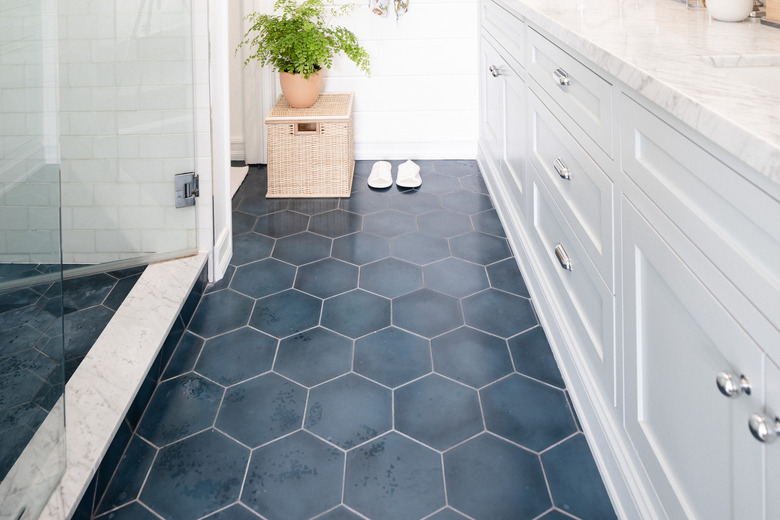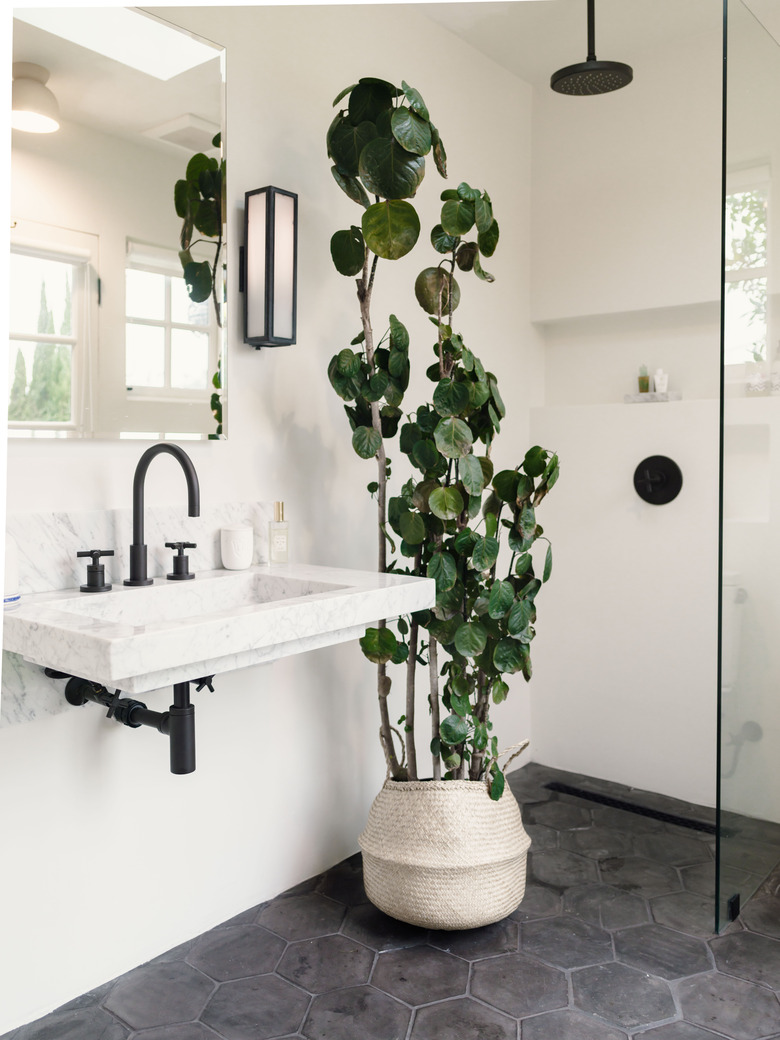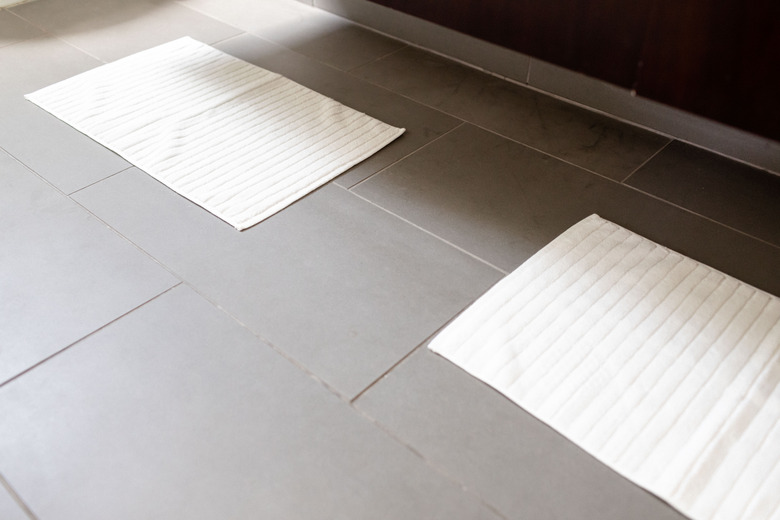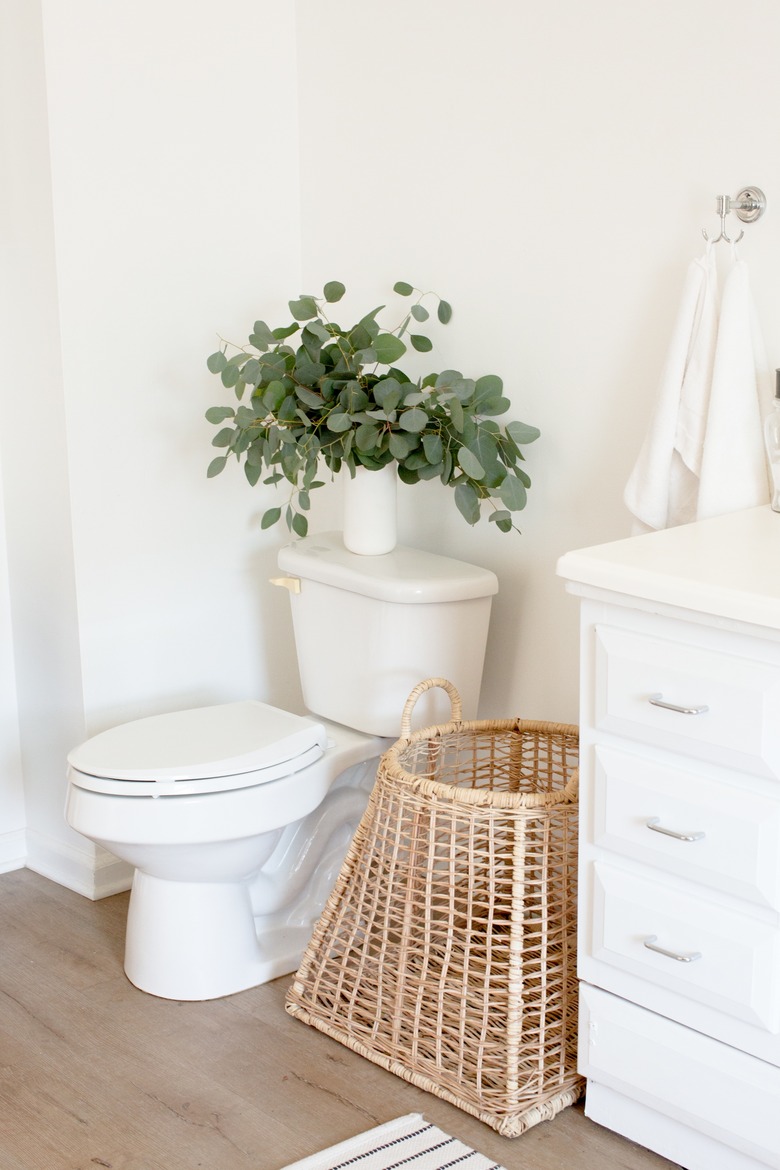Best And Worst Bathroom Flooring
Whether you're going for a luxury feel with your bathroom remodel or prefer a more utilitarian approach, at some point you'll need to determine the best flooring for your project. This is largely a matter of taste but not entirely so. Love them or hate them, there are some materials that work well on bathroom floors and others that just don't. Choose wisely or you could find yourself replacing your new bathroom flooring much sooner than you planned.
Best Flooring Traits
Best Flooring Traits
When you stop and think about it, homeowners place a lot of demands on bathroom flooring. You never know when your teenage daughter will decide to dye her hair (and half your bathroom) or when the dog will escape from the bathtub while still covered in shampoo. Carpet just isn't prepared to handle crises like these.
First and foremost, the floor needs to be waterproof or water-resistant at the very least. Splashed bathwater, overflowing toilets and plumbing leaks can all damage floors that can't withstand standing water. The floor must also be stain-resistant and easy to clean, whether a liquid or something firm like a mirror falls onto it. Durability is also a must.
No matter how durable, waterproof or easy to clean, a bathroom floor is no good if it's not safe. Because you'll be walking on it with wet feet at times, the best flooring won't get slippery when it's wet. Clearly, not every floor covering can do all of these things. You do, however, still have many choices available to you.
Best Flooring: Porcelain Tiles
Best Flooring: Porcelain Tiles
Porcelain tiles are an excellent choice for bathroom floors. Porcelain is made of natural clay mixed with sand and then fired at very high temperatures. The result is an extremely dense and durable tile that easily resists water and stains. Porcelain tile is also through-colored, meaning it's the same color all the way through the tile. This helps disguise chips if they do happen.
Once completed, porcelain tiles are left unglazed for a natural finish or glazed with a thin layer of glass. Unglazed tiles are slip-resistant but a bit harder to clean than their glazed counterparts. Glazing makes the tiles easier to clean and provides a wider array of color choices, and it can do so without compromising safety. Simply choose a matte or satin finish to get a glazed tile and slip resistance.
When shopping for porcelain tile, you will also encounter ceramic tiles. Porcelain tiles are actually a subset of ceramic, but the two are different. Made only of clay without the addition of sand, ceramic tiles get fired at lower temperatures and aren't quite as tough or dense as porcelain. Ceramic is also white beneath the glaze rather than through-colored like porcelain, so chipped tiles will stand out. As HomeAdvisor points out, ceramic is a bit less expensive than porcelain, and it will work on your bathroom floor if it better suits your budget.
Best Flooring: Sheet Vinyl
Best Flooring: Sheet Vinyl
If you're building on a budget, sheet vinyl may be the best flooring for your bathroom. Vinyl is extremely water-resistant and is easy to clean, making it a very bathroom-friendly material. Modern manufacturing methods also make it possible for vinyl to mimic the look of other materials. You can easily find a vinyl floor that looks like hardwood or natural stone without paying the high costs associated with these materials.
Another advantage of sheet vinyl is that, as its name suggests, it comes on a sheet. Installing your floor as a single piece means there are no seams or gaps through which water can seep. Even if you have a spill or leak and can't mop it up right away, there is little chance that the water will make its way under the floor to the subfloor beneath. This means less concern about rot or hidden problems like mold and mildew.
Best Flooring: Luxury Vinyl Flooring
Best Flooring: Luxury Vinyl Flooring
Not all vinyl is created equal. Available in plank form, manufacturers now produce a flooring material known as luxury vinyl. Sometimes called luxury vinyl plank, or LVP for short, this material can convincingly mimic the look of natural wood and stone. It's softer and warmer, however, making it feel more comfortable under bare feet.
Luxury vinyl comes in both waterproof and water-resistant varieties, making it an excellent choice for the bathroom. Not only is it forgiving when it comes to standing water, but luxury vinyl works over almost any type of subfloor. Naturally, the floor under the vinyl should be smooth and even, but Floor City notes that you can install luxury vinyl over cement, wood or an existing vinyl floor.
LVP is generally a great choice for bathrooms, but clawfoot tubs change the rules a bit. Because vinyl is softer than tile, installing LVP beneath a clawfoot tub will create indentations in the floor and may cause gaps to form between nearby planks. If you're considering a clawfoot tub, go with porcelain tile and take the proper steps to distribute the tub's weight.
Good Flooring: Natural Stone Tiles
Good Flooring: Natural Stone Tiles
Stone tiles can make a good bathroom floor, but you must choose wisely. Highly polished stones like marble make a poor choice because they're slippery when wet. You should also avoid porous stones like granite and travertine, which need constant sealing and are prone to absorbing both water and stains. Some porous stones can work but only if you're dedicated to sealing and maintaining them as needed.
If you want a stone floor, your best option may be slate. Available in colors from reddish hues to almost black, slate is tough and durable. It's much less porous than other stone, and it's naturally slip-resistant when wet. Slate is very easy to clean, requiring only regular sweeping and occasional mopping with mild detergent.
Note that stone flooring is expensive and heavy. It will last a very long time and will add value to your home, but you'll need a healthy budget and a sturdy subfloor to support it. If your current subfloor isn't up to the task, remember to leave room in your budget for beefing it up. Stone is also quite hard to cut and is unforgiving if installed improperly, potentially chipping and breaking if not laid correctly. As such, you'll likely want to pay for professional installation.
Good Flooring: Vinyl Tile and Linoleum Tiles
Good Flooring: Vinyl Tile and Linoleum Tiles
Vinyl and linoleum floor tiles both come in a stunning array of colors and patterns, are easy to clean and do provide water resistance in the bathroom. They're also inexpensive and quite easy to install yourself. Some get glued down, while others utilize a super easy peel-and-stick adhesive. They're also easy to cut when you need to work around a toilet or heating vent.
All of these traits make these tiles an excellent option when you're on a budget or doing a DIY install, but they do have a potential issue of which you should be aware. No matter how careful you are when installing them or how good of a job you do, these tiles will always have a small gap between them. This generally won't be an issue if you clean up spilled liquids right away and wring your mop well when cleaning the floor.
If, however, your bathroom springs a leak and standing water remains on the floor, some of it can and likely will seep beneath the tile and onto the subfloor beneath. This can lead to a rotting subfloor or mold and mildew forming beneath the floor. An isolated incident isn't likely to lead to a problem but it could. Although not a cause for panic, this issue is one to consider.
Worst Flooring: Hardwood and Laminate
Worst Flooring: Hardwood and Laminate
If a salesperson suggests putting hardwood or laminate flooring in your bathroom, politely excuse yourself and get out of there fast. This is always a bad idea. Hardwood feels nice beneath your feet, and it looks even better, but it won't after spending time in your bathroom. Wood is extremely sensitive to both water and humidity. That means that not only will standing water damage the surface if you have a leak but so will a hot, steamy shower.
When it reaches the breaking point, wood that is exposed to moisture and humidity will warp, crack and bend. Once it does, there's no going back. You can't fix it, and you'll have to bear the cost of ripping it out and installing something else.
The same is true of laminate. Laminate tends to be slippery when it's wet, and it can absorb water and humidity just like genuine hardwood. Even if it's made with special glues to prevent this, there will still be gaps between the boards that can let water through. Unfortunately, laminate is also impossible to sand down and refinish. If you do get a small spot of water damage, you'll have to replace one or more planks or the entire floor.
Worst Flooring: Cork Flooring
Worst Flooring: Cork Flooring
Whether it comes in a sheet or as tile, cork is another bad idea in the bathroom. Yes, it's soft to stand on, and yes, it's warm beneath your feet. It's also a giant sponge and a porous surface that's impossible to sanitize.
It's true that cork is naturally very slip-resistant, but it will be much less so after you add the multiple layers of sealant you'll need to use it in your bathroom. If that sealant cracks or wears away, your cork floor will absorb any liquid that comes into contact with it. Get it too wet and it will warp.
Even if a cork floor manages to recover well from a bit of water now and then, repeated exposure to water and humidity can cause it to expand and contract, ultimately leading to unsightly cracks in your floor. Cork is also likely to draw water down to the subfloor, which can loosen the adhesive and cause the cork to slip, possibly taking you with it as you step out of the tub or shower.
Worst Flooring: Carpet
Worst Flooring: Carpet
If you've ever smelled wet carpet, you already know where this is going. Like cork, carpet is warm and soft beneath bare feet and is quite slip-resistant. Also like cork, it's a giant sponge that you can't sanitize well. Carpet holds on to odors and germs that you just don't want hanging around, and it smells absolutely awful if it gets wet, which it's bound to do in a bathroom.
Once wall-to-wall carpet gets wet, there is no way to know for sure if you dried it quickly enough to avoid mold and mildew. Even if the carpet itself seems fine, the padding beneath may harbor germs or dampness. As is true of wood floors, humidity alone is enough to cause problems, even if your carpet hasn't gotten soaked with water. A carpeted bathroom often has a permanent musty smell that is impossible to get rid of completely.
If you just can't live without the feel of carpet under your feet in the bathroom, consider utilizing rubber-backed bath mats. These won't slip on hard floors, and you can toss them in the washing machine when you need to clean them. If that won't do, use an area rug that you can have professionally cleaned from time to time or can replace if it becomes necessary.
References
- HomeAdvisor: Porcelain vs. Ceramic Tile: Which is Better?
- Floor Critics: Best Flooring for Bathrooms
- Floor City: LVT Flooring: Pros and Cons of Luxury Vinyl Tile
- Flooring America: Luxury Vinyl Pros & Cons
- HomeAdvisor: Slate Flooring – Benefits & Drawbacks
- The Floor Shop: The Pros and Cons Of Laminate Flooring For Bathrooms
- BuildDirect: Cork Flooring in the Bathroom?
- Horizon Services: Top 10 Best and Worst Flooring Options for Your Bathroom



